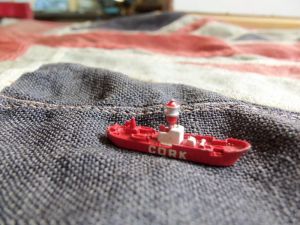Light Vessel M 737 Cork Triang Minic Ships 1959-64
Price: NZ$40.76
Code: BH338
Light Vessel M 737 Cork Triang Minic Ships 1959-64
British light vessels are commissioned, operated and maintained by the Trinity House Corporation in England, Northern Lighthouse Board in Scotland, and the Commissioners of Irish Lights in Ireland.
The Trinity House Corporation was founded in 1514 by royal charter of King Henry VIII with powers over the safety of shipping and control of pilots. When the charter was renewed by Queen Elizabeth the corporation’s role was extended to include the erection of beacons at sea but control over all lighthouses was not granted until 1836.
British light vessels are generally not self propelled, the space required for engines being used for generators and fuel, and are towed to their duty station by a tug or tender. They remain on station for several years at a stretch returning to port only for required maintenance and overhaul.
Vessels are known by their number and are not named as such. The name painted on the side of the vessel is the name of its duty station. Many of the Trinity House light vessels were built by Philip & Son Ltd of Dartmouth
Tri-ang Minic produced models of five light vessels, Sunk, Shambles, Cork, St Gowan and Varne. All of the models are identical except for the name painted in white on each side. There is no model number or model name marked on the underside.
SUNK was located in the Thames Estuary on the east coast of England
SHAMBLES marked a sandbar known as “The Shambles” between Portland and Weymouth off the south coast of England
CORK marked the “Cork Sand” in the English Channel off Felixstowe
VARNE marked “The Varne Bank” in the English Channel off Folkestone
ST. GOWAN was located near Milford Haven off the Welsh Coast
In worn original finish, some chipping and in a good play worn condition, a photo for each side has been provided to see the condition of the Name of each model.very good condition for its age. Unboxed model.
We have a very large collection of minic pieces to list if you are looking for anything in particular please email through the contact page on this site.
This section of the shop is about the amazing original series of diecast metal ships and harbour playset accessories, produced under the Tri-ang Minic Ships name in England between 1959 and 1964. As well as the later series of models produced under the Hornby Minic name during the early 1970’s.
The “TRI-ANG” trade mark itself resulted from a play on the truism “three lines make a triangle” the “three lines” in question being the brothers William, Walter and Arthur Lines who founded Lines Bros Limited just after the First World War.
The Tri-ang Minic Ships name comes from the original manufacturer Minic Limited a subsidiary of Lines Bros Limited, owners of the famous “TRI-ANG” trade mark.
The models were produced by Lines Bros Ltd’s Tri-ang Works at Mordon Road, Merton, London SW19 with production moving to Minic Limited at Market Way, Canterbury, Kent during mid 1960.
The original range of ships and harbour accessories are waterline models manufactured to a scale of 1:1200 scale, where one inch is equivalent to 100 feet, the same scale that was used in the manufacture of ship recognition models for training Allied naval and airforce personnel during both the First and Second World Wars.
When Lines Bros Ltd was broken up in the late 1960’s the “TRI-ANG” trade mark remained with Tri-ang Pedigree, another Line Bros subsidiary which was also active in New Zealand and Australia, while the “MINIC” trade mark was transferred to Hornby together with the tooling for the Minic Ships models.
All of the models produced under the Hornby Minic name were produced in Hong Kong after Hornby moved their manufacturing in the early 1970’s. Hornby produced only a limited selection of the original models but also introduced four new models of famous battleships – USS Missouri, IJN Yamato, DKM Bismarck and DKM Scharnhorst.All of the ship models produced under the Hornby Minic name were fitted with a red plastic base equipped with plastic rollers.
The original Tri-ang Minic and Hornby Minic series of models are no longer in production and to the best of our knowledge the tooling for these models no longer exists. So the original models have become quite collectable as they were only made for 6 years and being mainly children’s toys, many sadly have not survived. What has is in various states of repair! Still they are an incredible early 1960’s toy which can be arranged in attractive displays, and enjoyed in many homes or businesses where a nautical theme is desired.




